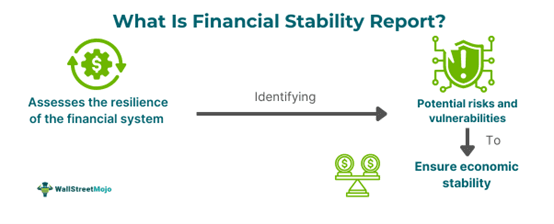Table of Contents
What Is Financial Stability Report?
A financial stability report is a summary by the Federal Reserve assessing the current resilience and position of the U.S. financial system. Such publications help the Federal Reserve Board maintain accountability and transparency.

Financial stability ensures that the financial markets operate smoothly and that banks, credit unions, and other lending institutions can extend loans and credit to households, businesses, and communities. In a stable financial system, the economy experiences stable prices, full employment, and a robust banking, payments, and financial system.
Key Takeaways
- The financial stability report gauges the overall health and resilience of the U.S.
- financial system, including the banking system, payment system, infrastructure, and financial markets.
- It highlights possible systemic risks, vulnerabilities, and shocks that may hinder the performance of the U.S. financial system and adversely affect the economy.
- The Federal Reserve Board publishes such a report for public use to ensure transparency and accountability in the U.S. economic system.
- It emphasizes four critical aspects: funding risks, asset valuation, borrowings by households and businesses, and financial sector leverage.
Financial Stability Report Explained
The Financial Stability Report is the Federal Reserve's analysis of the strengths and resilience of the U.S. financial system. It identifies potential systemic risks, vulnerabilities, and shocks that may arise in the near future. The financial system comprises the banking system, payment system, financial markets, regulatory bodies, financial instruments, infrastructure, and financial services. This report is publicly released to maintain transparency and accountability in financial disclosures.
The report assesses various aspects that may disrupt the efficiency of the U.S. financial system:
- Asset Valuation: Changes in the valuation of assets like corporate bonds, federal bonds, real estate, and other assets can influence interest rate volatility and liquidity in financial markets.
- Borrowings by Households and Businesses: The current outstanding debts of households and businesses can determine debt market conditions and the risk of potential non-repayment.
- Financial Sector Leverage: Analyzing the leverage position of banks, credit unions, broker-dealers, and other financial institutions is critical to understanding the soundness and stability of the banking sector.
- Funding Risks: Funding risks arise when banks fail to maintain sufficient liquidity, which can limit the operating funds necessary for seamless functioning.
Although the Federal Reserve assesses various risks to the U.S. financial system, its current approach may only partially quantify these uncertainties. However, the Federal Reserve team, including experts, staff, academics, and other professionals, is working to improve its measures to identify potential vulnerabilities in the financial system.
Examples
Let's understand the concept with the help of the following hypothetical and real-world examples.
Example #1
The Federal Reserve Financial Stability Report released in April 2024 identifies key concerns about policy uncertainty, primarily driven by the upcoming November U.S. elections, ongoing inflation, and monetary tightening. These factors, along with stress in the commercial real estate sector and potential vulnerabilities in the banking sector, present risks to financial stability. The Bank Term Funding Program (BTFP) has been critical in ensuring liquidity for smaller banks. Despite these challenges, the Fed reports that the overall financial system remains stable, with high levels of liquidity in banks and a solid ability to service debt among businesses and households. However, the equity and bond markets have been influenced by higher-than-expected inflation and sustained interest rates.
Example #2
Imagine a central bank in a mid-sized economy releasing its Financial Stability Report, highlighting key risks to the nation's financial system. The report expresses concerns over heightened market volatility due to policy uncertainty surrounding upcoming national elections. Persistent inflation and high interest rates are straining household and corporate balance sheets. While larger banks maintain robust capital buffers, smaller regional banks, especially those exposed to commercial real estate (CRE) loans, are showing signs of stress.
Suppose the report emphasizes a new liquidity support program introduced to aid smaller banks, which has provided essential funding to over 1,800 institutions. Despite these measures, vulnerabilities remain in the CRE market and among life insurers with illiquid assets. The central bank concludes that the financial system is stable but warns that continued vigilance is necessary to address evolving risks.
Importance
The central bank of many countries, including the U.S., releases a financial stability report to assess the nation's economic condition, potential risks, and the soundness of the financial system. Let us understand this significance in detail below:
- Determines stability of the financial system: The financial stability report evaluates whether the financial system is efficient and competent in supporting business entities, households, and communities and whether its lending capacity is resilient to minor economic shocks. This analysis is essential for the smooth functioning of the economy.
- Gauges financial vulnerabilities: It provides insights into any prevailing systemic risks or potential stresses that can interrupt the seamless functioning of the financial system. Such vulnerabilities are categorized as funding risks, high borrowings by households and companies, valuation pressures, and high leverage in the financial sector.
- Establishes accountability: The report highlights the reasons and sectors facing hardship or potential disruptions, suggests possible measures, and creates accountability within the financial system.
- Ensures transparency: The financial stability report is made available to the public, helping maintain transparency in disclosing the actual position of the economy.
- Identifies potential shocks: In addition to vulnerabilities, the Federal Reserve identifies and closely monitors any possible domestic or international adversities or shocks that may negatively impact the financial system.
